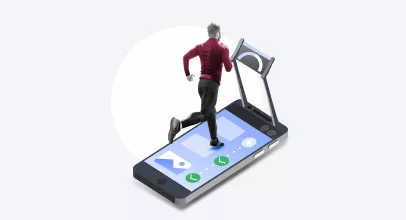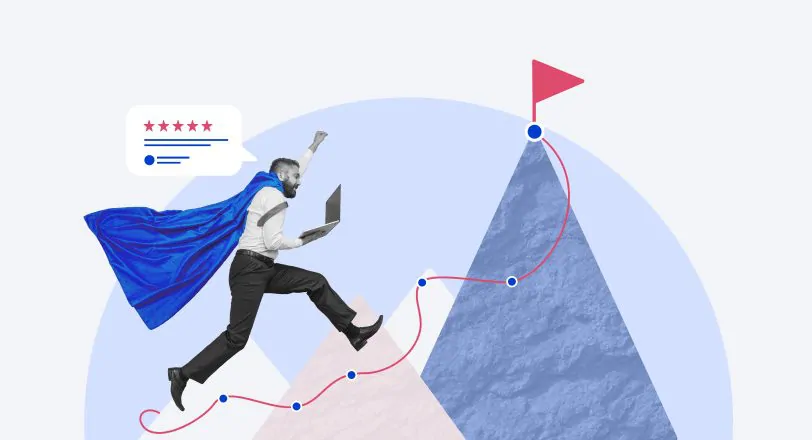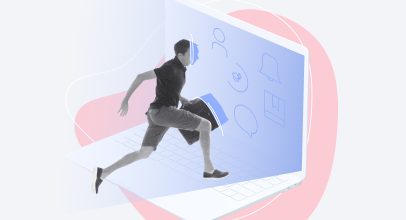Customer Education: A Beginner’s Guide
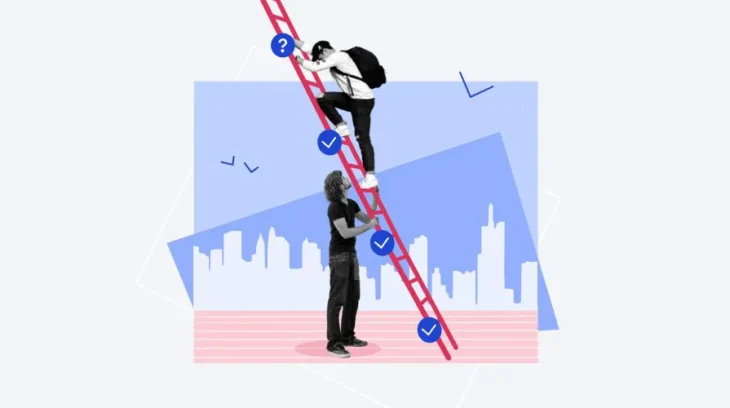
In this article, you’ll learn why customer education is important to building loyalty and increasing retention. We’ll explore how training your customers can help you achieve desired business goals through increased satisfaction and long-term relationships. You’ll get a 7-step guide on how to launch an effective customer education program and receive some best practices, as well as customer training examples.
When a customer purchases your product, you want them to be able to navigate it easily, use its full range of features, and extract the greatest possible value from it. But how do you facilitate a successful client learning experience?
Customer education is by no means a new notion, but the way that businesses train clients has been transformed in recent years. In this article, we’ll explore how educating clients will help you boost their chances of success with your product.
What is Customer Education?
Customer education is the process of providing relevant knowledge and skills to customers to help them understand a product or service better and use it effectively.
This is usually achieved by providing a set of learning programs or educational content created by the business. It can include product manuals, video tutorials, and eLearning courses to help customers troubleshoot issues. You can also offer webinars or virtual classroom training sessions to deepen their product knowledge and facilitate the customer journey. The idea is to guide users through the entire process – from customer onboarding all the way to their mastery of the product.
Why Is It Important to Educate Your Customers?
Imagine empowering your customers to achieve their business strategy with the help of your product or service.
The importance of customer education lies in its ability to enhance customer satisfaction and drive long-term success. By providing the needed knowledge and support, you position your brand as a trusted mentor.
1. Strengthen customer relationships
By providing valuable information, you empower decision-makers to make informed choices that lead to a more satisfying experience with your products. This not only boosts their confidence in your brand but also increases the chances of them returning as customers and recommending your brand to others. Client education can generate feedback that can be used to enhance your products.
2. Increase product adoption and usage
When customers understand the full potential of your product, they’re more likely to explore its features and use it to its fullest extent. Customer education empowers users to solve problems independently, leading to increased satisfaction and reduced support queries. This higher level of engagement translates to stronger product usage rates, ensuring that your solution becomes an integral part of their workflow.
3. Reduce customer churn and boost retention
A well-educated customer is less likely to transition to a competitor because of confusion or frustration. By offering training and resources, you can address pain points before they become justifications for churn. Educated customers are also more inclined to renew contracts or upgrade to higher-tier plans, directly affecting your bottom line and fostering long-term business growth.
Benefits of Educating Customers
There’s no doubt that investing in educating your customers leads to long-term success and growth for your business. The real question is how. Here are the key benefits of consumer education for your consideration:
1. Onboard customers more quickly
Almost every digital product involves product onboarding, which is essential for customer education in service marketing. A customer education program should include a set of instructions and tips on how to use the product, as well as additional learning resources: help docs, guides, online courses, etc. A successful customer education program lets your business provide a faster onboarding process to more customers and scale up easily.
2. Reduce the support team’s workload
A customer support team and customer success managers often spend their days answering the same questions over and over. This is not only frustrating, but it’s also not an efficient or cost-effective use of your customer service time, as it uses up valuable resources. Explore the frequently asked questions and include them in your customer education content. This will reduce the number of support tickets, thus lightening your support staff’s workload. As a result, your customer success team will be more available for higher-impact client interactions, and your customer support costs will be reduced.
3. Build customer loyalty and become a lovemark brand
All successful businesses have one thing in common: they know how to manage their customer lifecycle and engender loyalty in their clients. When a business invests in customer education, it fosters a stronger connection with the brand and thus reduces the chances of clients switching to a competitor. By generating loyalty, your customers become brand advocates, boosting brand awareness through word of mouth and growing your customer base.
4. Position your brand as a market leader
Investing in successful customer education positions your brand as the market expert. By sharing high-quality, industry-specific knowledge, your business can show existing and potential customers that you know the field better than any of your competitors. This inspires trust, thereby increasing customer satisfaction scores and helping your business convert your target audience to customers.
How to Launch a Customer Education Program
As you can see, leveraging the benefits of customer education helps you retain customers and ensure their long-term satisfaction with your products and services. But it’s a big investment for a business. If you’re unsure how to train consumers, use this guide as a starting point in creating a customer training plan. Here’s a closer look:
Step #1: Set up goals
The first step toward implementing your customer education program is to define its goals. This will help you clarify what you’re trying to achieve and serve as a baseline that will be used to measure the results of your customer learning program. Align the goals of your customer education initiative with your company’s expected business outcomes.
Step #2: Assess your current customer education program
Once your education team has defined your goals, it’s time to audit your current learning resources if you already have some kind of customer training in place.
Analyze the ins and outs of what your company does and what resources or materials are available by asking the right questions:
| Question | To do |
| What resources are available? | Collect the customer guides, onboarding emails, and other important existing training content. |
What role does each team have in customer education? | Customer education affects several teams, so get to know the role that each team plays, how they currently train new and existing customers, and how they align the training materials with the defined goals. |
| What customer education tools do you need? | List the tools you’ll need to implement your customer education initiatives. For example, to provide your end user with online training, you’ll need:
|
| Online courses | An online course is self-paced virtual training. The key characteristics of online courses include:
Online courses can be:
|
Step #3: Decide on the educational content
The next step for course creators is to decide which format you’ll use for your customer product training. Customer education training can be conducted in a number of ways. Here are 6 of the most common approaches:

Now let’s look at how to educate customers using different learning methods and content types in more detail so you can see which is the best choice for your particular needs.
| Type of training | Details | Benefits |
| Customer help documents | Customer help documents include:
These can be shared:
|
|
| Corporate blog | A company blog is a fantastic way to offer high-level educational content related to:
This can be shared:
|
|
| Product onboarding emails | Curating a series of product onboarding emails can help drive customer development by sharing:
This can be shared:
|
|
| Training videos | There can be different kinds of video tutorials that can be used:
These can be shared:
|
|
| Webinars and live demos | Customer success teams play a significant role in training customers. They can carry out several types of training, including:
These can be recorded and shared:
|
|
| Online courses | An online course is self-paced virtual training. The key characteristics of online courses include:
Online courses can be:
|
|
To drive customer development effectively, a blended learning approach works best. By combining online courses with live sessions led by a customer education team, corporate blog posts, and help documents, you increase the chances of having more successful customers.
Step #4: Map out your training program
You’ve defined the business objectives, audited the current customer training strategy, and chosen your tools. So, what’s next? It’s time to map out the training program. At this stage, it’s important to use the data you gathered in the previous stage to understand what objectives you can help consumers achieve.
When outlining your customer education program, factor in the following considerations:
Determine the learning objectives and goals
Delineate what the key learning outcomes for customers are and how your training program can get them there. Develop a maximum of three learning goals that you want your learning program to achieve and three to five objectives per goal.
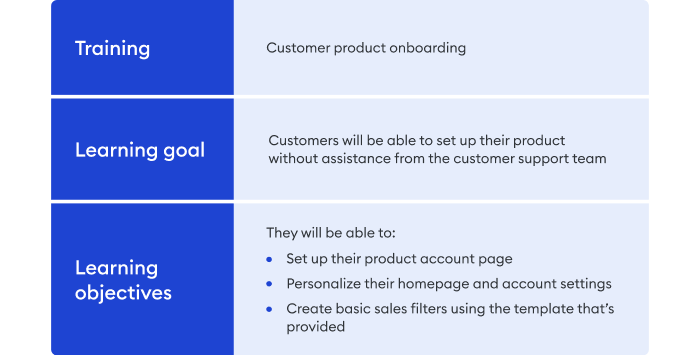
Want to know more? Read this article on how to set learning goals and objectives for online courses.
Identify subject matter experts (SMEs) in the company to lead the way
The vast experience of a subject matter expert makes them an essential part of the creation process. Utilize the expertise of your product team to provide ideas on case studies, interactive activities, or other essential materials.
Capture content ideas
Put your heads together to come up with a content mix. Outline all the types of customer education content you want to include to make your training dynamic. For example, use video, visuals, knowledge checks, and simulations to build an education program that your learners will enjoy.
Define the length of the content
Define the length of your lessons and keep this consistent so customers know how much time they need to dedicate to each one. Customers are short on time, so bite-sized lessons work best.
Decide on a delivery method
Think about when and where your customers will take the training. Most consumers will do this on the go, so it needs to be available anywhere, anytime. For maximum engagement, your customer education content should work on all types of devices.
Research how successful companies train customers
When outlining your training program, explore how other companies successfully educate their consumers and use this as a source of inspiration.
Step #5: Create learning content
Once your customer education program is defined, it’s time to create educational content. This is where course authoring software comes into play. If you want to provide your customers with versatile interactive content that engages them, opt for a well-rounded tool like iSpring Suite Max.
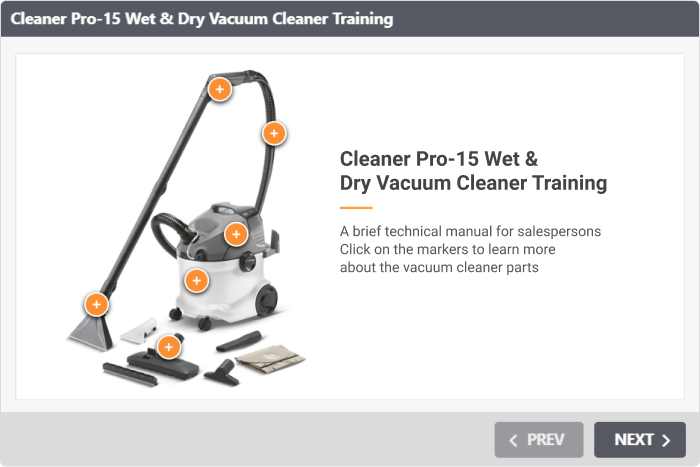
A slide from the course created with iSpring
With iSpring Suite Max, you can:
- Build online courses on any topics you wish in a matter of minutes, right in PowerPoint.
- Use ready-made slide templates and images of characters and locations to make professional-looking content.
- Engage customers with interactive activities such as role-plays.
- Create quizzes and assessments to check customers’ knowledge.
- Educate and engage consumers with video.
- Create multi-device online learning content.
- Collaborate on content together with your team in a single online workspace.
- Update your content with ease whenever needed.
Step #6: Deliver learning content
Once you’ve created your educational content, you need to share it with your end users and/or clients. Of course, you’ll publish general educational materials on your website, blog, and YouTube channel, but it’s difficult to evaluate their effectiveness – if it only comes through customer feedback. And you want to clearly understand if you have an effective customer education program that brings good business results and helps grow your customer lifetime value. For this, you’ll need a learning management system.
When choosing the right customer education software, consider the following factors:
Is it user-friendly?
Your customer education LMS is the tool your clients will have the most contact with, so opt for one that’s intuitive and easy to use. Search for a platform that users can navigate from day one.
Can it record metrics?
You’ll need a way to measure the success of your customer education efforts and share the results with your leadership team. It’s best to invest in an LMS with strong analytical capabilities so you can demonstrate the value of the education program in terms of customer satisfaction, engagement, and performance. It also offers invaluable insights into how the program can be improved.
Is it scalable?
Your customer education tools need to grow with the business. That’s why choosing a scalable LMS is a must. These are the main features of a scalable platform:
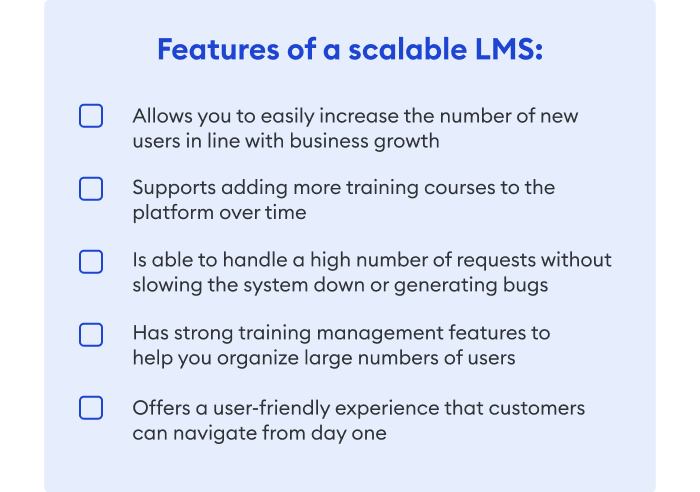
If you still don’t have a customer training platform, you can try the iSpring Learn LMS. It’s powerful in terms of functionality but has an intuitive design, so it will be perfect for trainers and trainees who have never used a learning system before.
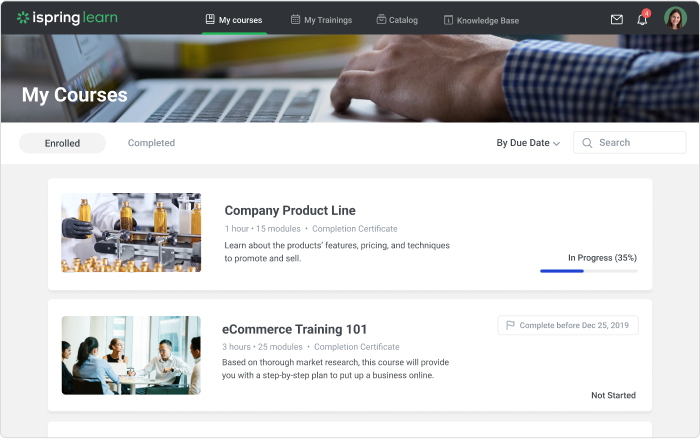
iSpring Learn interface
iSpring Learn will help you create your own online academy that will let you:
- Segment audiences to offer personalized learning paths.
- Develop courses with the integrated iSpring Suite authoring toolkitand the built-in course editor.
- Automate training management tasks like managing deadlinesand sending invites and reminders.
- Create comprehensive custom reports for evaluating the successof your customer education programs and measuring user engagement.
- Customize the platform with your business branding for a seamlessuser experience.
- Utilize the native mobile app to deliver on-the-go learning.
- Amp up your customer engagement training with gamification tools, like badges, certificates, and points.
- Scale your training in line with the business goals, building on yourprogram over time.
Step #7: Use data to evaluate your results
Rolling out your customer training is only the beginning. Once it’s live, you’ll need to gauge its success. There are different ways to do this: сheck LMS reports, send surveys, use star rankings, and create an open channel for feedback. The more you know, the more you can improve your training program. It’s crucial to address your customer expectations, so take their feedback into consideration and react.
Customer Education Programs: Examples
Now let’s take a closer look at how executing those steps helps companies create successful product training for customers. Here’s the list of the top three client training programs to examine for inspiration.
| Customer education program | Description |
| Hubspot Academy | HubSpot Academy is the ultimate learning hub for marketing and sales. They create an exceptional amount of learning and marketing content and they know how to keep their customers educated. It produces courses and customer education certification to help clients level up their marketing, sales process, and service motions. |
| Gusto Academy | Gusto is an online payroll and HR management platform. In addition to helping companies automate compensation, Gusto’s tools support everything from hiring and onboarding processes to employee productivity and benefits. Gusto customer education Academy offers not just product education, but industry education that benefits all HR functions. |
| Webflow University | Webflow is a website creation platform that caters to those with little engineering experience. It enables its customers to spend less time coding and more time designing their dream site. Webflow’s client learning program offers all forms of training, from product certification programs and courses to support documentation. |
Metrics for Measuring Customer Training Results
If you conduct training via an LMS, you have the opportunity to monitor the learners’ results and changes in behavior. All LMSs have a variety of reports. Let’s take a look at customer education metrics that can be measured with iSpring Learn.
1. Learner progress
These reports give a full overview of how customer training is working. They give insights into how engaged customers are. Low results could indicate that customers aren’t aware of the training, don’t find it relevant, or are having access issues.
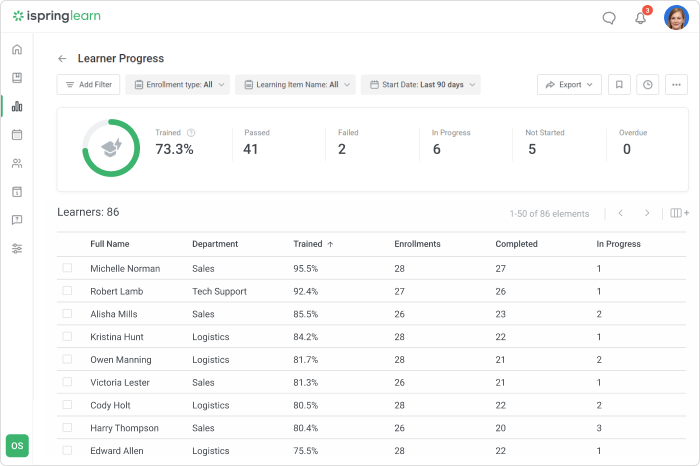
This report details how many courses have been completed and how each customer performs.
2. Learner results
This report gives a detailed picture of how an individual customer is performing. This information is crucial if a particular client is having issues, reaching out to your customer support team frequently, or has submitted a complaint.
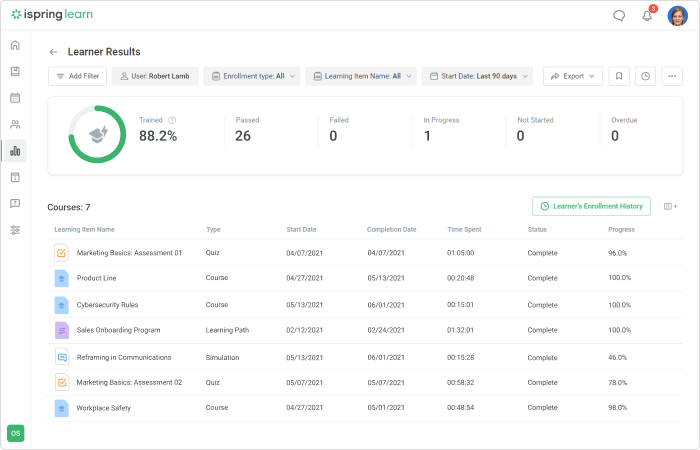
You can see the content assigned to the consumer, the time spent with each lesson, and
the number of attempts made.
3. Course details
Course detail reports provide customer education teams with the right metrics for analyzing how customers are progressing with a specific course. Keep an eye out for consistently low test scores, as this could indicate that the quiz is too difficult or needs clarification. On the flip side, if all customers are getting the maximum score on assessments, you might want to make the lesson more challenging.
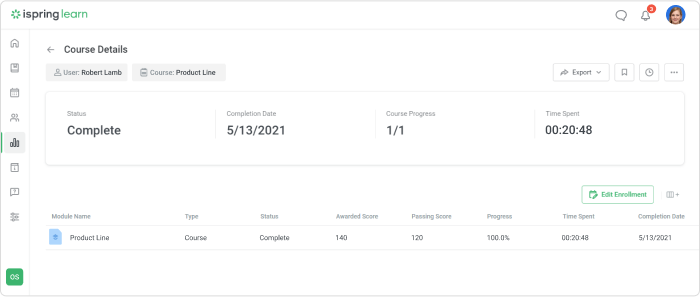
You can check which modules have been completed, the time spent on each one,
when a customer completed the course, and how they performed on assessments.
4. Progress achievements
This report works perfectly for exams and assessments of users’ knowledge levels. If your customer training program offers certification upon completion, this data allows you to see who has been certified and when.
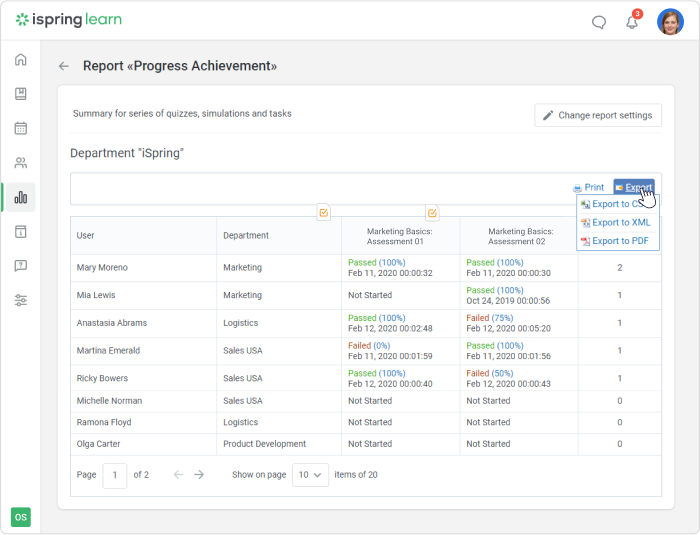
This report shows how customers are progressing via online assessments.
Want to know more? This handy article on LMS reporting will let you know how to utilize the analytics.
Customer Education Best Practices
Creating customer education eLearning courses in-house is a surefire way to train your customers effectively, but it requires some research and skills. Here are some tried-and-true customer training best practices to transform simple users into expert users of your products:
Assign customer education roles
A successful customer education program requires a dedicated team with clearly defined roles to design, deliver, and refine training initiatives. Common roles include:
- Customer Education Manager. Oversees the strategy and execution of training programs, ensuring alignment with business goals and customer needs.
- Instructional Designer. Develops engaging, pedagogically sound course materials, incorporating adult learning principles and diverse learning styles.
- Subject Matter Expert (SME). Provides in-depth knowledge of the product or service, ensuring accuracy and relevance of the content.
- Customer Success Manager. Collaborates with customers to identify specific learning goals and ensures that the training program meets their expectations.
- Learning Technologist. Manages the technical delivery of eLearning, maintaining platforms, analytics, and user experiences.
Together, these roles create a cohesive team to deliver highly impactful education that drives customer success and loyalty.
Stick to bite-sized learning
Microlearning is the most effective way to educate clients. Customers are on-the-go learners who want their training at the point of need. Microlearning, when done well, boosts customer retention and engagement. To utilize microlearning for customer education, divide a one-hour online lesson into smaller chunks, or microlessons.
Learners respond best when these microlessons include knowledge checks and interactive training content that oblige them to recall what they’ve just learned. Adding time limits to these lessons helps build momentum and add a gamified element.
Use a variety of learning styles
Everyone learns differently. To give your customers the best chance of understanding and retaining the educational content, tap into different learning styles. We’ve put together an overview of five common learning styles to implement in your training program, including clear-cut examples of how to incorporate them into your customer education strategy:
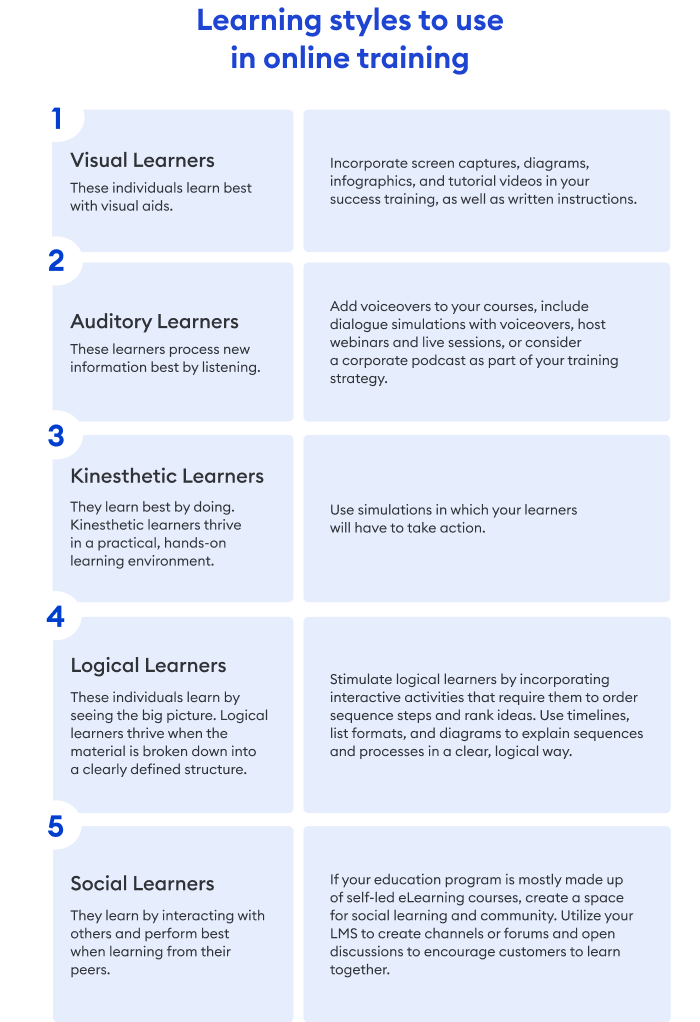
Keep your style consistent
Add variety to your customer training through different types of interactions, storytelling, and creative use of multimedia, but keep your look and feel consistent. Before making your first lesson, invest some time building a clear style guide to follow.
As a general rule, the following elements should remain consistent:
- Tone of voice. Whether it’s conversational or professional, keep the tone of voice consistent throughout your lessons.
- Look and feel. Color palettes, fonts, call-to-action buttons, page layout, etc., should be standardized to facilitate seamless navigation for learners.
- Image style. Keep the style of images consistent throughout your content. For example, try not to mix cartoon images with photos.
- Negative space. Negative space is the blank space on each slide of your course. Don’t overcrowd your slides, and keep a consistent amount of blank space throughout.
Personalize your content
Excellent consumer education engages learners, helping them to retain knowledge. A critical driver of customer engagement is creating training that feels relevant and tailored to the individual. You can achieve this with some nice touches, like adding the learner’s name to the welcome page, customizing the end-of-course screen, and segmenting learners into relevant groups on your customer education platform.
Customer Education Examples
Here are a few customer education examples you might want to check out to learn how actual companies educate their customers to facilitate successful product adoption.
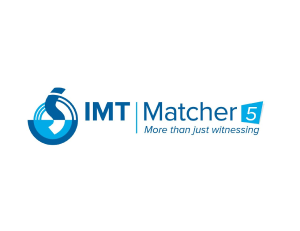
IMT Matcher
IMT Matcher (TM) provides IVF management technologies and quality management systems to fertility centers, donor banks, and other Assisted Reproductive Technology (ART) centers.
Learn how the company is training its rapidly growing customer base worldwide and was able to reduce user education costs by 25%.

BEST SAP
Another educational training example is BEST, an official SAP partner focused on developing, implementing, and supporting SAP add-on products.
Learn how the company built a new approach to customer education during the COVID-19 pandemic and reduced user training time from 3 days to 6 hours.
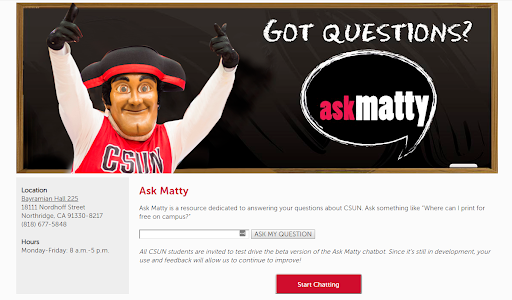
California State University, Northridge’s Mobile App
One of the best examples of customer service in higher education is California State University Northridge’s mobile application.
Learn how this school uses its mobile application with an integrated chatbot to improve customer experience in education.
FAQ on Customer Education
How can I train my customers?
Customer training should ensure that users can apply your product or service effectively. Implement a structured training program that includes live sessions, eLearning modules, and gamified activities. Use role-based or use-case-specific training to cater to individual customer needs, and offer certifications to motivate participants and validate their expertise. Get a free trial of the iSpring Learn LMS to see how easy it is to launch automated learning for customers.
How can I educate my customers about my product?
- Create clear, engaging, and accessible resources that cater to different learning styles.
- Craft detailed customer onboarding materials, such as user guides, video tutorials, and interactive FAQs.
- Offer webinars or live demos to provide a hands-on experience, and follow up with refresher courses or advanced modules to help customers explore advanced features.
How can I educate customers about my service?
- Focus on demonstrating value through real-world applications.
- Provide clear documentation, step-by-step walkthroughs, and personalized consultations to address customer needs.
- Use case studies and success stories to show how other clients have benefited from your service.
- Consider creating self-service resources, like an online knowledge base, for 24/7 accessibility.
How can I improve customer education?
- Regularly gather feedback through surveys or direct communication to identify gaps in your program.
- Invest in a learning management system to deliver scalable, personalized experiences.
- Keep content updated with the latest product or service changes, and incorporate engaging formats, such as interactive videos, quizzes, and simulations, to maintain learner interest.
What is the difference between education and training?
Education focuses on building knowledge and understanding, emphasizing “why” something works or is beneficial. Training, on the other hand, is practical and skills-oriented, teaching users “how” to perform specific tasks or achieve desired outcomes. Both are critical to customer success: education fosters a deeper connection with your product or service, while training ensures effective application in real-world scenarios.
Conclusion
In this article, we talked about the importance of customer education and why it is no longer just a “nice-to-have” element, but a vital component of any business. By teaching clients to utilize your products or services to their fullest, you create an ecosystem of confident users who are more likely to stay loyal, advocate for your brand, and even become ambassadors.
With clear strategies, measurable results, and a commitment to excellence, your organization can harness customer education as a powerful driver of loyalty, retention, and business impact.
